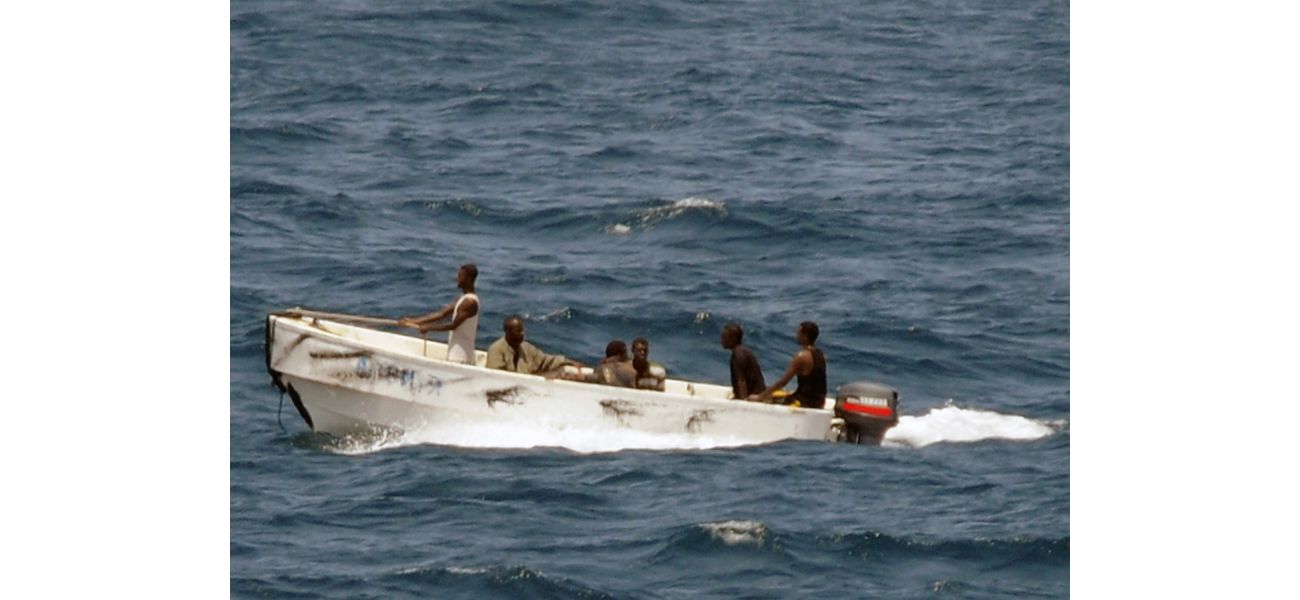Ocean danger costing global economy $37B/yr.
60 cases of piracy and robbery have been reported on the high seas in the first half of 2024.
October 18th 2024.

When you hear the word "pirate," what comes to mind? Perhaps it's a swashbuckling rogue with a sword in hand, like Captain Jack Sparrow. But in reality, modern-day pirates are much different from their romanticized counterparts.
Long gone are the days of corsairs, buccaneers, and privateers that roamed the seas in the 14th century. Today, piracy takes on a more violent and dangerous form. Armed with assault rifles, modern pirates attack cargo ships, take hostages, and threaten the global trade industry.
In fact, in just the first half of 2024, the International Maritime Bureau's Piracy Reporting Centre received 60 reports of piracy and armed robbery, resulting in 85 crew members being kidnapped. It's a significant issue that continues to affect the maritime industry and the global economy.
But what exactly do we mean by "piracy" in the modern world? According to the IMB, it's defined as "an act of boarding a ship to commit theft or any other crime, with the intent or ability to use force to facilitate that act." The International Maritime Organization (IMO) has a similar definition, stating that piracy occurs on the high seas or in areas outside the jurisdiction of any country's laws.
However, the IMO also specifies that the attack must take place in a specific location for it to be considered an act of piracy. This nuance highlights the challenges of addressing and combatting modern piracy.
So what exactly do modern pirates do? Unlike their historical counterparts, they often use speed boats to attack cargo ships. They may steal merchandise or attempt to take over the ship and demand a ransom. In some cases, they also take crew members hostage to secure a ransom payment. With around 80% of world trade carried out by sea, there are plenty of targets for modern pirates and a significant amount of money to be made.
Despite efforts to combat piracy, it is still a prevalent issue in the 21st century. However, there has been a decline in incidents in recent years. In 2023, the IMB reported 120 incidents of maritime piracy and armed robbery against ships, a substantial decrease from the 298 incidents reported a decade prior in 2013. This trend is also reflected in data from Crime at Sea: A Global Database of Maritime Pirate Attacks, which shows a steady decline in piracy since 2010.
But where are modern pirates most active? The majority of attacks occur in the Asia-Pacific region and around Africa. Data from the Journal of Open Humanities and the International Chamber of Commerce shows that between 1993 and 2024, almost 47% of all pirate attacks took place in East Asia and the Pacific. Sub-Saharan Africa had the second-highest number of incidents, followed by Latin America and the Caribbean, and the Middle East and North Africa.
One particular hot spot for piracy is the Gulf of Guinea, where attacks often involve violence and hostage-taking. Other areas known for high rates of piracy include the Gulf of Aden, Arabian Sea, Strait of Malacca, Sulu and Celebes Seas, Indian Ocean, and Falcon Lake.
Despite the decline in overall incidents, modern pirates still pose a threat to seafarers. In fact, the IMB reported a significant increase in crew kidnappings in the first half of 2024, with 85 crew members being taken hostage compared to just 36 in the same period the previous year. Somali piracy also remains a concern, and countries like Bangladesh and Indonesia have reported record-high numbers of incidents in recent years.
Piracy has a long history, and it continues to be a threat to this day. In the Caribbean, where piracy first emerged in the 1500s, there are still occasional incidents, although on a much smaller scale than during the height of the piracy era. Western European and North American navies cracked down on Caribbean piracy in the 1830s, but it has since resurfaced in certain areas due to economic struggles or local fishing turf wars.
Notable incidents involving modern-day pirates include the 2009 hijacking of the Maersk Alabama cargo ship, which was depicted in the film Captain Phillips. Other notable attacks on ships carrying valuable cargo have occurred in recent years, highlighting the ongoing challenge of piracy.
While it may seem like something out of a movie, modern piracy is a real threat to seafarers and the global economy. Despite efforts to combat it, piracy remains a significant issue in certain parts of the world. It's a reminder that history and reality don't always align, and the image of the swashbuckling pirate may be a thing of the past, but the danger they pose is still very much alive.
Long gone are the days of corsairs, buccaneers, and privateers that roamed the seas in the 14th century. Today, piracy takes on a more violent and dangerous form. Armed with assault rifles, modern pirates attack cargo ships, take hostages, and threaten the global trade industry.
In fact, in just the first half of 2024, the International Maritime Bureau's Piracy Reporting Centre received 60 reports of piracy and armed robbery, resulting in 85 crew members being kidnapped. It's a significant issue that continues to affect the maritime industry and the global economy.
But what exactly do we mean by "piracy" in the modern world? According to the IMB, it's defined as "an act of boarding a ship to commit theft or any other crime, with the intent or ability to use force to facilitate that act." The International Maritime Organization (IMO) has a similar definition, stating that piracy occurs on the high seas or in areas outside the jurisdiction of any country's laws.
However, the IMO also specifies that the attack must take place in a specific location for it to be considered an act of piracy. This nuance highlights the challenges of addressing and combatting modern piracy.
So what exactly do modern pirates do? Unlike their historical counterparts, they often use speed boats to attack cargo ships. They may steal merchandise or attempt to take over the ship and demand a ransom. In some cases, they also take crew members hostage to secure a ransom payment. With around 80% of world trade carried out by sea, there are plenty of targets for modern pirates and a significant amount of money to be made.
Despite efforts to combat piracy, it is still a prevalent issue in the 21st century. However, there has been a decline in incidents in recent years. In 2023, the IMB reported 120 incidents of maritime piracy and armed robbery against ships, a substantial decrease from the 298 incidents reported a decade prior in 2013. This trend is also reflected in data from Crime at Sea: A Global Database of Maritime Pirate Attacks, which shows a steady decline in piracy since 2010.
But where are modern pirates most active? The majority of attacks occur in the Asia-Pacific region and around Africa. Data from the Journal of Open Humanities and the International Chamber of Commerce shows that between 1993 and 2024, almost 47% of all pirate attacks took place in East Asia and the Pacific. Sub-Saharan Africa had the second-highest number of incidents, followed by Latin America and the Caribbean, and the Middle East and North Africa.
One particular hot spot for piracy is the Gulf of Guinea, where attacks often involve violence and hostage-taking. Other areas known for high rates of piracy include the Gulf of Aden, Arabian Sea, Strait of Malacca, Sulu and Celebes Seas, Indian Ocean, and Falcon Lake.
Despite the decline in overall incidents, modern pirates still pose a threat to seafarers. In fact, the IMB reported a significant increase in crew kidnappings in the first half of 2024, with 85 crew members being taken hostage compared to just 36 in the same period the previous year. Somali piracy also remains a concern, and countries like Bangladesh and Indonesia have reported record-high numbers of incidents in recent years.
Piracy has a long history, and it continues to be a threat to this day. In the Caribbean, where piracy first emerged in the 1500s, there are still occasional incidents, although on a much smaller scale than during the height of the piracy era. Western European and North American navies cracked down on Caribbean piracy in the 1830s, but it has since resurfaced in certain areas due to economic struggles or local fishing turf wars.
Notable incidents involving modern-day pirates include the 2009 hijacking of the Maersk Alabama cargo ship, which was depicted in the film Captain Phillips. Other notable attacks on ships carrying valuable cargo have occurred in recent years, highlighting the ongoing challenge of piracy.
While it may seem like something out of a movie, modern piracy is a real threat to seafarers and the global economy. Despite efforts to combat it, piracy remains a significant issue in certain parts of the world. It's a reminder that history and reality don't always align, and the image of the swashbuckling pirate may be a thing of the past, but the danger they pose is still very much alive.
[This article has been trending online recently and has been generated with AI. Your feed is customized.]
[Generative AI is experimental.]
0
0
Submit Comment





